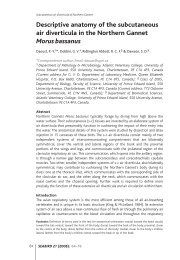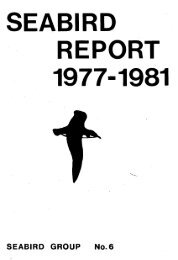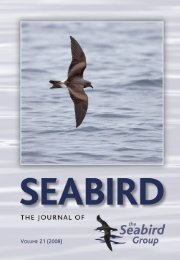You also want an ePaper? Increase the reach of your titles
YUMPU automatically turns print PDFs into web optimized ePapers that Google loves.
2001 Body mass reduction in Kittiwakes 165<br />
REDUCTION IN BODY MASS AND BASAL<br />
METABOLIC RATE IN BREEDING FEMALE<br />
BLACK-LEGGED KITTIWAKES RISSA<br />
TRIDACTYLA: AN ADAPTATION TO REDUCE<br />
MAINTENANCE COSTS?<br />
INGVEI G LANGSETH, BØRGE MOE & CLAUS BECH<br />
Langseth I., Moe B. & Bech C. 2001. Reduction in body mass and basal metabolic rate in breeding<br />
female Black-legged Kittiwakes Rissa tridactyla: An adaptation to reduce maintenance costs?<br />
Atlantic <strong>Seabird</strong>s 3(4): 165-178. We studied changes in body mass and basal metabolic rates (BMR)<br />
in breeding female Black-legged Kittiwakes Rissa tridactyla on Svalbard (79°�, 12°E) in 1997 and<br />
1998. Measurements of body masses and BMR were obtained two weeks before hatching, at<br />
hatching, early in the chick-rearing period and late in the chick-rearing period. During incubation,<br />
body mass and mass specific BMR remained relatively stable. From hatching to late chick-rearing,<br />
body mass and mass specific BMR decreased by 12% and 26% respectively. However, from about<br />
two weeks up to about four weeks into the chick-rearing period, body mass and BMR did not change<br />
significantly. Whole body BMR scales with body mass 2.18 . This exponent is greater than that<br />
expected for a homomorphic variation in BMR, and indicates that the reduction in BMR must<br />
involve properties other than an overall body mass reduction. <strong>The</strong> simultaneous reduction in body<br />
mass and BMR could result from a negative energy balance, leading to a reduction in the masses of<br />
metabolically active organs. Alternatively, a reduction in BMR could be an adaptation to<br />
compensate for an elevated activity level during the chick-rearing period. By a reduction in the<br />
adult’s maintenance costs, more energy can be allocated for promoting chick growth.<br />
<strong>No</strong>rwegian University of Science and Technology, Department of Zoology, NO-7491 Trondheim,<br />
<strong>No</strong>rway, E-mail: ingveig.langseth@chembio.ntnu.no<br />
INTRODUCTION<br />
Most birds face an energetic challenge during reproduction because this period<br />
often involves an increase in activity and a reallocation of energy from self<br />
maintenance and survival to egg formation, incubation and chick growth. Since<br />
both time and energy may be limiting resources, the adult birds often experience<br />
a reduction in body mass, and consequently also in body condition, during<br />
reproduction (Moreno 1989). This reduction in body mass has generally been<br />
considered to be a consequence of energetic stress (Ricklefs 1974; Harris 1979;<br />
Drent & Daan 1980; Ricklefs & Hussel 1984; Monaghan et al.1989; Moreno<br />
1989). However, some evidence exists that a reduction in body mass is part of a<br />
mechanis m that compensates for the increased level of activity during<br />
reproduction, either by reducing the cost of flying (Freed 1981; <strong>No</strong>rberg 1981)<br />
or by reducing energy consumption at rest (Deerenberg et al. 1998).








